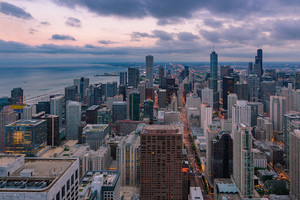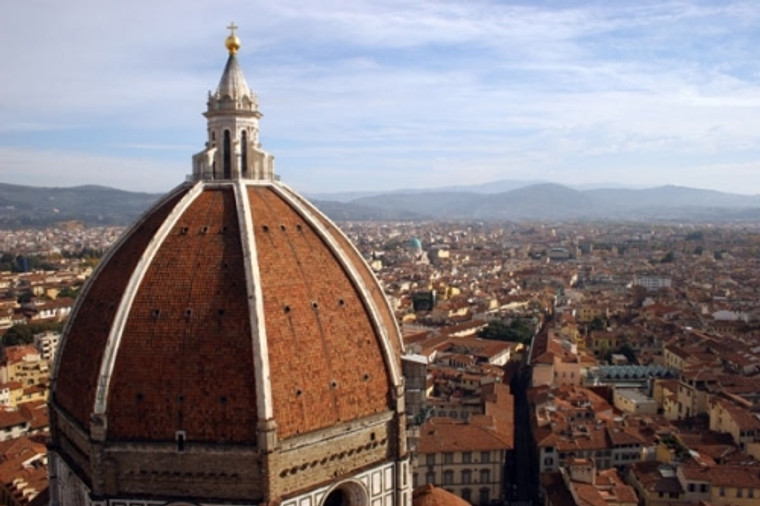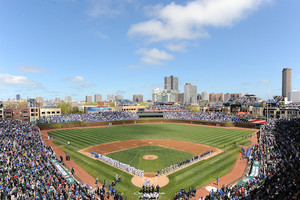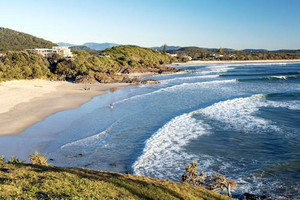
It dominates the skyline of Florence, standing sentinel over the city that gave birth to the Renaissance, and the Campanile’s 414 steps ends with one of the most distinctive panoramas in Europe. As we climb yet another level of the Campanile, the well-worn stone steps become steeper and the walls and ceiling of the stairway shrink, forcing us into a low crouch, and somewhere ahead of us in the dark someone asks: “Are we nearly there yet?” It’s a question that runs through minds of most people who attempt the steep ascent to the top of the 84 metre gothic bell tower, and the physical exertion is rewarded on the final platform at the top - the red roofs and church spires of Florence colour the landscape up to the Tuscan hills in the distance.
Down below, horse drawn carriages clip-clip along the cobbled streets, and artists set up displays in the piazza ahead of the expected influx of visitors later in the morning. But the real glory of this hard-earned vista is the Cathedral of Santa Maria del Fiore, known locally as il Duomo, because of Filippo Brunelleschi’s cupola which crowns the magnificent building. In a city that’s crammed full of fantastic churches, monasteries, palaces, museums and towers, this is the epicentre of the birthplace of the Italian Renaissance and it inspires and uplifts not just art lovers, but even the most stubborn philistines.
Florence In A Nutshell
It was the birthplace of the golden age, and as many visitors quickly discover, in Florence it is possible to walk in the footsteps, and visit the final resting places, of the modern world’s great artists and engineers. The Duomo itself is an important symbol of the Renaissance - and not just a stunning landmark. Brunelleschi’s cupola was an ingenious engineering feat which required unique methods and equipment which transformed the way building design was carried out. His methods were used in many of Europe’s famous domes, including St Peters in Rome. Its importance to the people of Florence is also summed up by the locals’ phrase for being homesick - nostalgia del cupolone - which literally means “homesick for the dome”.
In Florence, the Duomo and the Campanile are merely the starting points of an exploration of a city which reveals one surprise after another in a place that really hasn’t changed much since the 16th century. Tucked in just behind the Duomo is the Battistero, or Baptistry, which is one of Florence’s oldest structures with foundations that date back to the 4th and 5th centuries. Its ornate doors make this one of the special sights of Florence and one man, Lorenzo Ghiberti, spent most of his adult life from 1403-52 making these vast structures. The originals have been removed and stored to prevent damage from pollution but the copies that have replaced them are no less impressive.
Walking Florence’s cobbled streets takes you in the footsteps of the likes of Michelangelo, Dante and Botticelli and it seems that at the end of each street there’s a piazza, or square, with famous statues and sophisticated cafés to sit down, have a real espresso, and take it all in. The most famous square is the Piazza della Signoria, which has been the civic centre of Florence since it was built around the end of the 13th century. It’s dominated by the 14th century Palazzo della Signoria and has a swag of other important buildings around it including the Uffizi Gallery, the Loggia della Signoria, the Palazzo Uguccioni and the Palazzo del Tribunale de Mercanzia.
Justifiably, the Uffizi Gallery is considered one of the best in Europe with an unmatched collection of Renaissance paintings and sculptures including works by Michelangelo, Sandro Botticelli, Rembrandt, Raphael, Titian and Caravaggio. The museum occupies the top floor of the Palazzo degli Uffizi which is right on the Arno River and queues begin forming at the Uffizi from well before its 8.30am opening time. It’s not uncommon to wait several hours to simply enter the museum, but it is possible to reserve tickets by telephone in advance at an extra cost to beat the crowds.
The Ponte Vecchio And Beyond
But perhaps the most enduring image of Florence is the Ponte Vecchio, or Old Bridge, which has spanned the Arno River since the 14th century. It was also the only bridge in Florence that escaped destruction in WWII. Originally, this is where butchers, grocers and blacksmiths plied their trade but in 1593 the Medici grand duke Ferdinand I ordered these traders off the bridge. His private corridor which linked his palace to his office in the Uffizi crossed over the top of the shops and he wanted the plebeian rabble out, and he allowed goldsmiths in, and they remain there until this day. The anarchical structure now houses jewellery and souvenir shops, which are geared towards the hordes of tourists that cross every day.
A little further down river, the Basilica di Santa Croce (Basilica of the Holy Cross) is one of the finest examples of Italian Gothic architecture - with the possible exception of the Campanile - and the principal Franciscan church in Florence is also the home of some of the original Renaissance artwork and is the burial site for some of the golden age’s famous figures. Michelangelo’s tomb is right inside, and legend has it that he nominated that spot so that on Judgment Day when the graves of the dead open up, the first thing he would see would be the Duomo through the church doors. Galileo Galilei’s tomb is also inside, along with that of Niccolo Machiavelli and Ghiberti. Standing among the tombs of some of the most influential “minds” in history is a humbling, yet uplifting, experience and is a fitting way to depart one of the truly important historical cities in the world.
- By:
- Ben Hall
Reviews
-
Use ALL Your Senses in Florence
This is a terrific review of the High Art aspect of Florence, but it makes the city sound very formal. Yes, Florence is filled with art and history, but it also offers wonderful tastes and scents of food and drink, the feel of fine leather, the sound of street music. The people were wonderful, as were the dogs. Add a little on to your review about how to experience Florence, not only look at it, and it will be perfect!














